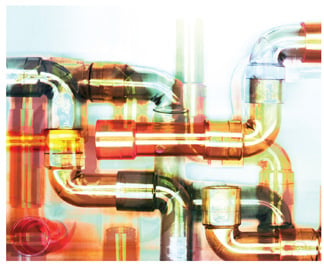 A major concern related to pipes and fittings is the potential for damage when they fail and leak. Chlorinated polyvinyl chloride, commonly referred to as "CPVC," is a thermoplastic used to produce pipes and related fittings. CPVC applications include water supply pipes, water-based heat transfer systems, and sprinkler systems and drain lines, in both commercial and residential buildings.
A major concern related to pipes and fittings is the potential for damage when they fail and leak. Chlorinated polyvinyl chloride, commonly referred to as "CPVC," is a thermoplastic used to produce pipes and related fittings. CPVC applications include water supply pipes, water-based heat transfer systems, and sprinkler systems and drain lines, in both commercial and residential buildings.
Since introducing the thermoplastic about 40 years ago, manufacturers have marketed CPVC components as less expensive (and easier) to install when compared to metal piping products, such as black iron pipe and copper.
With the growing popularity of CPVC and its adoption in building construction on an international level, the threat of damage from the failure of pipes and fittings has increased. It is therefore beneficial for claims professionals, adjusters specifically, to learn the basic properties of CPVC and how it fails so as to identify subrogation opportunities and recoveries involving these pipes and fittings.
|Identifying CPVC
Whatever the specific cause, leak damage can be extremely costly, ultimately resulting in large-loss claims. Determining if CPVC pipes and fittings were either the direct cause or a contributing factor in a property loss therefore becomes critical. Identifying whether a pipe or a particular fitting is made of CPVC is usually the first step in the investigation. CPVC pipes and fittings can be found at retail home product stores, usually in a yellow or cream color, which is generally marketed for use in residential construction for domestic water applications. Because these components are sold in retail home product stores, they can be used by a do-it-yourselfer with little or no training or product experience.
Recommended For You
Want to continue reading?
Become a Free PropertyCasualty360 Digital Reader
Your access to unlimited PropertyCasualty360 content isn’t changing.
Once you are an ALM digital member, you’ll receive:
- Breaking insurance news and analysis, on-site and via our newsletters and custom alerts
- Weekly Insurance Speak podcast featuring exclusive interviews with industry leaders
- Educational webcasts, white papers, and ebooks from industry thought leaders
- Critical converage of the employee benefits and financial advisory markets on our other ALM sites, BenefitsPRO and ThinkAdvisor
Already have an account? Sign In Now
© 2025 ALM Global, LLC, All Rights Reserved. Request academic re-use from www.copyright.com. All other uses, submit a request to [email protected]. For more information visit Asset & Logo Licensing.








